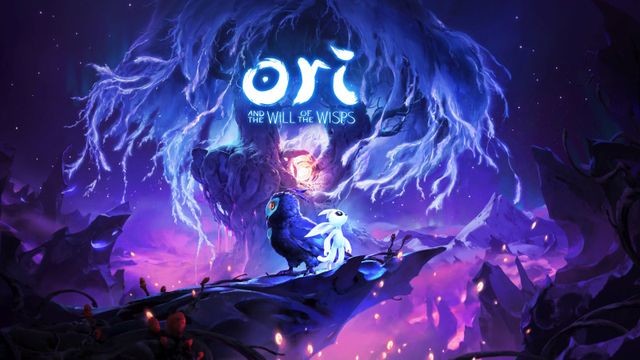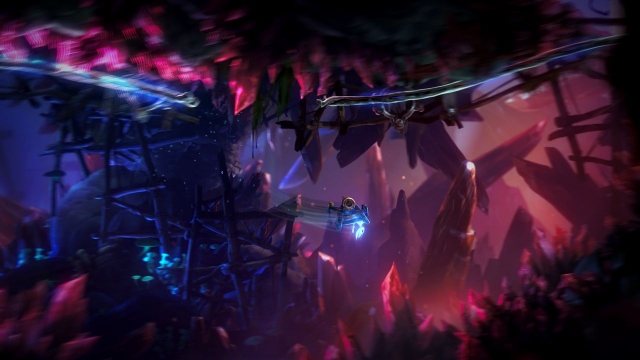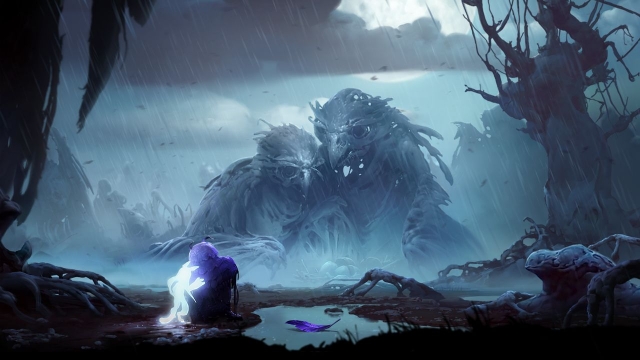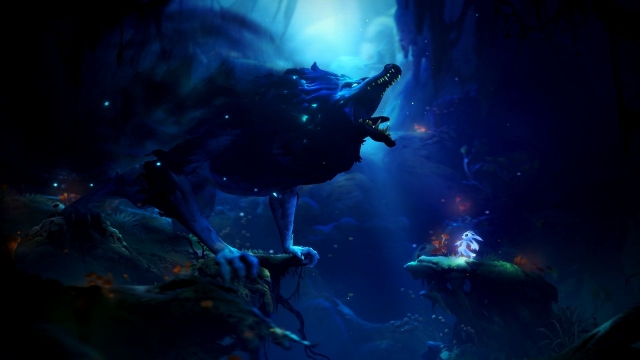Ori and the Will of the Wisps

2015 saw the release of Ori and the Blind Forest and with that one game, Microsoft seemingly had a sleeper hit on their hands. This touching Metroidvania tugged at the heartstrings right away and allowed players who enjoyed that platforming sub-genre to do something you usually don’t have to in that style of game – care deeply about the characters involved because the narrative forces you to. And it doesn’t do this by cramming exposition down your throat – but by showing you their lives and the impact they have on one another. The tale of Ori and Kuro was one that will never be forgotten by those who played it – and now the story continues with Ori looking after former rival Kuro’s daughter Ku.
Their journey begins with Ori helping Ku gain the ability to fly thanks to finding Kuro’s feather before they fly off into a storm. The storm takes them away from one another and the journey now becomes how each survives. Ori is who you’ll use throughout most of the adventure – but Ku does get some time in the spotlight. Ori’s the featured act, but Will of the Wisps puts a nice emphasis on side characters from the get-go. Beyond having some act as exposition dumps, you get shopkeeps to help you along your journey and a pretty generous helping of currency for toppling foes too. Unlike a lot of Metroidvanias that have a slow start and a slow beginning overall, this one starts off slow, but speeds up quickly and keeps the pace fast.
In the first 15 or so minutes, you have minimal access to any kind of offense and have to learn to play defensively. This is very similar to how the first game started, but with a much faster overall start time before you could really get into the action. Here, you can enjoy a nice prologue to set things up or if you so desire, skip it and jump right into things. I recommend playing the prologue because it builds the world up quite a bit and re-establishes bonds that were forged in the first game in such a way that it shows a lasting bond was made between the characters. Combat starts off faster here than in the first – and it’s more diverse as well.
In the sequel, you have longer-range melee attacks thanks to a light sword that can slice and dice enemies up pretty quickly. It’s also able to take care of a lot of environmental obstacles – but not all. A lot of them require context-sensitive attacks to resolve alongside a bit of logic. The sequel is more of a puzzle-platformer than the original, so you’ll have to flex your mental muscles earlier than before to solve the puzzles needed to move on. Fortunately, the puzzles are largely logic-based and involve moving something like a rock over to a certain place to get to a new area or use your arrow to move bridges around to form a new path to an area.
There’s a lot more attack variety here that helps keep the action fresh. Being able to have a finely-ranged sword early on makes this feel far more action-focused than the first – even with it being more puzzle-centric than the original. This helps the game be a better experience for those who want more action in their Metroidvanias and don’t mind a bit of puzzle-solving alongside it. The sword alone makes you feel like a badass and adding in things like a light boomerang for range and the bow and arrow really make this feel like a better and more diverse game than the first. You still have a heavy emphasis on the music between the notes thanks to the strong character work, but now it works so much better as a complete experience thanks to the stronger emphasis on combat.
The core action-platforming is more finely-tuned now than it was before, and the end result is a better experience for players. Combat flows better and the series is now top-shelf when it comes to delivering an action-packed Metroidvania experience. The prior game did a fine job of setting up the world, but combat was a bit lacking and made up for in spades thanks to the storytelling being best-in-class for the genre. Now, you get that alongside great combat and it results in a fun time from beginning to end.
Visually, Ori and the Will of the Wisps looks a bit better than the original – but largely excels at higher-fidelity resolutions now. The original game was fine for 1080p, but with the increase in details on both characters and environments, the whole world pops better now than it did before. Everything has been optimized with higher-end hardware in mind now – resulting in not only more varied color schemes for environments, but far better usage of effects on things like water reflections and depth – making the world seem so much more real now than before. The massive jump in animation quality helps too – as attacks now feel brutal and impactful whether you’re giving them or receiving them.
Musically, the Ori games have delivered some of the most atmospheric sound design on the market – and Will of the Wisps is no different. The soundtrack is soothing throughout much of the adventure, but does ramp up when it needs to. Boss battles are intense, and the sound design with a stellar set of headphones shines quite a bit – with the soundtrack’s depth coming across even better than it does though a set of TV or computer speakers.
Ori and the Will of the Wisps succeeds where the original game faltered while maintaining everything that made it work. The spirit of the first game lives on with a touching tale of life, love, and loss that just so happens to have some of the tighest combat in a side-scrolling game on the market today. It’s a more exciting game than the original and an improvement on something that was already so well-crafted is quite an accomplishment. Ori and the Will of the Wisps is a must-play game for anyone who loves side-scrolling action-platformers and sends you on an emotional journey from beginning to end.
Reviewed By: Jeremy Peeples
Publisher: Xbox Game Studios
Rating: 97%
——————————————————————————–
This review is based on a digital copy of Ori and the Will of the Wisps for the Xbox One provided by Xbox Game Studios.
 Game Over Online
Game Over Online











